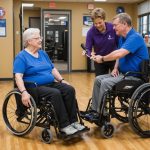Understanding Sedentary Lifestyles
A sedentary lifestyle is characterized by a lack of physical activity, often associated with sitting or lying down for extended periods. This prevalent behavior is increasing globally, largely due to technological advancements and routine desk jobs. The impact of inactivity is substantial, leading to multiple health concerns that can’t be overlooked.
Prolonged inactivity poses several health risks, including an increased chance of developing chronic diseases such as obesity, cardiovascular diseases, and Type 2 diabetes. Moreover, individuals who lead inactive lives may experience diminished physical health, affecting their overall well-being.
Have you seen this : Top Strategies for Supporting Cognitive Wellness in Older Adults: Best Practices for Healthy Aging
The effects of a sedentary lifestyle extend beyond just physical health. There is a notable impact on mental health, with inactivity contributing to depression, anxiety, and general mood disturbances. Lack of movement is linked to reduced psychological energy and resilience, exacerbating these issues.
To combat these challenges, it’s vital to understand the importance of integrating regular physical activity into daily life. By doing so, not only can the health risks associated with prolonged inactivity be mitigated, but mental health can also see a significant improvement, helping individuals lead overall healthier and more fulfilling lives.
Importance of Physical Activity
Engaging in regular physical activity offers a multitude of benefits that enhance both mental and physical health. When individuals participate in exercise, they experience improvements such as increased energy levels and a better mood. The positive effects extend to mental wellbeing, with physical activities releasing endorphins that act as natural mood lifters.
These activities also play a crucial role in preventing chronic diseases. For instance, consistent exercise can reduce the risk of Type 2 diabetes, heart disease, and certain cancers. Maintaining a routine of physical activity strengthens the immune system and contributes to maintaining a healthy weight, enhancing overall physical health.
Additionally, there’s a strong link between exercise and mental health. Aerobic exercises and strength training are known to alleviate symptoms of depression and anxiety, promoting cognitive function and emotional stability. Not only does physical activity provide immediate mental boosts, but it offers long-term benefits such as improved memory and reduced cognitive decline as one ages.
Therefore, adopting a lifestyle that prioritises physical activity can transform health outcomes, offering individuals both short-term gains and lasting benefits. Incorporating exercise into daily life creates a foundation for a healthier and more positive future.
Setting Realistic Goals
Setting achievable fitness goals is crucial for cultivating a sustainable active lifestyle. By creating goals that are both clear and attainable, individuals are more likely to succeed. The SMART criteria—Specific, Measurable, Achievable, Relevant, and Time-bound—is a proven method for effective goal setting. Each element aids in crafting a roadmap that guides individuals towards their health objectives.
Having personal motivation plays a pivotal role in pursuing these goals. It’s important to identify what genuinely drives you, whether it’s improved health, weight loss, or simply feeling more energetic. Personal motivators ignite the desire to maintain progress, even when challenges arise.
To keep motivation levels high, progress tracking is a valuable tool. By regularly monitoring achievements and adjustments, you create a visual representation of progress, which reinforces the value of your efforts.
- Break down larger goals into smaller, manageable tasks.
- Celebrate milestones, no matter how minor they seem.
- Reflect on personal growth and improvements.
These tips not only empower individuals to remain focused on their personal targets, but they also foster a sense of accomplishment that fuels future endeavours in fitness and health.
Finding Enjoyable Activities
Incorporating physical activity doesn’t have to be a chore; it can be a source of excitement and joy. Identifying fun activities that align with your personal exercise preferences can greatly enhance your motivation. Whether you enjoy dancing, cycling, or hiking, there’s a vast array of diverse options that can cater to your interests and fitness levels.
One approach is to explore activities that are adaptable to various ages and abilities. This not only ensures inclusivity but also keeps exercise routines fresh and engaging. For instance, yoga can be adapted for all age groups, providing a fun yet beneficial workout.
Incorporating social aspects can further boost enjoyment. Engaging in group activities or teaming up with friends or family can transform workouts into a social event. This adds an element of fun and creates accountability, making it easier to stick to your routine.
Remember, the goal is to find activities that you look forward to, turning them into a gratifying part of your day. Discovering exercise preferences and trying out different playful exercises can make the journey towards a healthier lifestyle enjoyable and sustainable long-term.
Building a Supportive Environment
Creating a supportive environment is crucial for sustaining lifestyle changes. Social support plays a vital role, offering accountability and encouragement. Without it, the journey towards a healthier life may seem daunting. An effective strategy involves developing an accountability system by partnering with friends, family, or a dedicated fitness group. These partners can provide feedback, celebrate achievements, and help maintain focus.
Engaging in community involvement further bolsters support. Participating in local fitness groups or online forums connects you with like-minded individuals sharing similar goals. This creates a valued sense of belonging and encouragement. Community initiatives often offer structured programs, tailored to various fitness levels and interests.
- Create a buddy system for consistent check-ins.
- Join fitness classes or clubs for group motivation.
- Utilize social media groups for sharing progress and tips.
This approach not only creates accountability but also fosters motivation through shared experiences and mutual encouragement. As you build a network of supportive peers, you gain access to collective wisdom and inspiration, enriching your fitness journey. An inclusive and collective environment enhances the likelihood of maintaining an active lifestyle, thus promoting long-term habit formation.
Utilizing Technology for Engagement
Leveraging technology can revolutionise your fitness journey. With the rise of fitness apps, tracking activity and maintaining enthusiasm is more accessible than ever. Apps such as MyFitnessPal and Fitbit offer real-time data on progress, goal setting, and even meal planning. These tools play a significant role in sustaining long-term engagement and accountability.
Moreover, online resources have expanded exponentially, providing an abundance of virtual workouts suitable for various proficiency levels. Platforms like YouTube and Peloton supply a wealth of classes, from yoga to high-intensity interval training (HIIT), taught by experienced instructors. By offering flexibility and convenience, these resources assist users in easily incorporating exercise into hectic schedules.
In addition, technology can provide automated reminders and motivation. Many apps send notifications to encourage regular activity, and some even allow for community interaction. Joining online fitness groups or challenges is a fantastic way to engage with others, fostering a motivational environment.
- Track your progress with fitness apps.
- Explore virtual workouts for added convenience.
- Utilize reminders and community challenges for consistent motivation.
Through integrating technology in fitness, adapting to an active lifestyle becomes not just feasible, but enjoyable and rewarding.
Tailoring Strategies for Different Demographics
Adapting exercise routines to fit various age-specific activities is crucial for promoting overall health. By recognizing the unique needs of each age group, individuals can engage in inclusive and enjoyable workouts.
For seniors, low-impact exercises such as swimming and tai chi are ideal. These options offer gentle strength-building and flexibility without overwhelming joints. For younger adults, more vigorous activities like running or HIIT (High-Intensity Interval Training) can be more appealing, offering robust cardiovascular benefits.
Inclusive fitness considers any physical limitations individuals may have, introducing adaptive fitness solutions. These may include wheelchair-friendly sports or modified yoga classes, allowing everyone to participate in a manner that suits their abilities.
Addressing diverse needs ensures that everyone can engage in physical activity, regardless of age or physical condition.
- Seniors: Focus on activities like walking, water aerobics, or strength training.
- Younger Adults: Experiment with cycling, team sports, or dance classes.
- Adaptive Fitness: Explore chair-based workouts or personal trainers specializing in modifications.
By embracing this tailored approach, exercise becomes an inclusive, lifelong habit, fostering health across generations. This strategy not only meets the physical requirements of diverse groups but also encourages active living as a community.
Sharing Success Stories
Real-life success stories serve as potent motivators, illustrating how seemingly insurmountable challenges can be overcome. By showcasing individuals who have transitioned from a sedentary lifestyle to active living, these stories inspire others to embark on their own transformative journeys.
Take Anna, for example, who was initially overwhelmed by the prospect of regular exercise but found yoga and group classes enjoyable and motivating. Her story highlights the importance of finding exercise preferences that align with personal interests. For Anna, participating in these engaging activities shifted her routine, leading to improved mental wellbeing and overall physical health.
Another inspiring case is Mark, who utilized technology to support his fitness journey. With reminders and encouragement from fitness apps, he maintained a consistent routine, achieving his health goals by leveraging digital tools to stay on track.
These success narratives demonstrate the profound impact of integrating fun activities and supportive structures into daily life. Sharing such experiences emphasizes practical takeaways: finding what brings joy, the value of a supportive community, and the powerful role of technology in sustaining an active lifestyle. By drawing on these real-life examples, you can discover tangible ways to embrace change and inspire others.
Encouraging Sustainable Habits
Creating sustainable lifestyle changes requires embedding physical activity into daily routines. Start by incorporating small bursts of movement throughout the day, such as short walks during breaks or opting for stairs instead of elevators. These simple actions solidify the foundation for lasting habit formation.
Consistency is key when forming new habits. Develop a routine by scheduling workouts at similar times each day, which helps establish a rhythm and reduces the risk of missed sessions. Even on busier days, maintaining brief exercise commitments ensures steady progress.
Celebrating small victories is crucial; acknowledging these achievements reinforces motivation. For instance, if you’ve completed your first week of consistent exercise or have increased your workout duration, take a moment to appreciate the milestone. Recognition reinforces positive behaviour and encourages perseverance.
- Integrate activity into daily routines to build lasting habits.
- Cultivate consistency with a regular fitness schedule.
- Appreciate minor achievements to boost ongoing motivation.
Embedding regular physical activity into your life not only promotes consistency but paves the way for healthier habits. By focusing on incremental progress and consistency, sustainable changes become more achievable, leading to improved physical health and enriched mental wellbeing over time.











